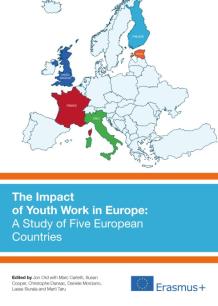The Impact of Youth Work in Europe: A Study of Five European Countries

The book is in two sections. Section 1 begins with a chapter providing the background to European youth work policy and argues that the EU and the Council of Europe have played an important part in defining youth work across a broad spectrum of member states. However, it has also been quite explicit in its policy priorities such as increasing employability and social inclusion, as well as more recently in its focus on combating extremism. The chapter argues that as a result of the explicit setting of policy priorities tension arises, which has the potential to run counter to the autonomous actions of youth workers and youth work’s person-centered practice, the aims of which emerge out of the engagement of youth workers with young people and which cannot be prescribed in advance. The book then has five distinct but related chapters on the context of youth work in each of the five partner countries – the UK (England), Finland, Estonia, Italy and France. Each of these chapters plots the development of youth work in the respective countries and draws out the key policy priorities. Section 1 is completed by an introduction to the methodology of transformative evaluation which has been utilized in this project. Section 2 focuses exclusively on the findings of the project. After a brief introduction to the approach taken in the analysis of findings, there are five distinct chapters focusing on the findings from each of the five countries. It is important to point out that there was considerable coordination of the project in the initial establishment and implementation stages (for example, through the first and second transnational learning activities and the production of a training manual). However, the countries operated autonomously, and in particular the analysis was done independently. This met the specific intention of ensuring the assessment of the data was not influenced by any of the other four country groups. The book culminates in a comparison of youth work across the five countries and offers some tentative conclusions as well as some recommendations for further research.